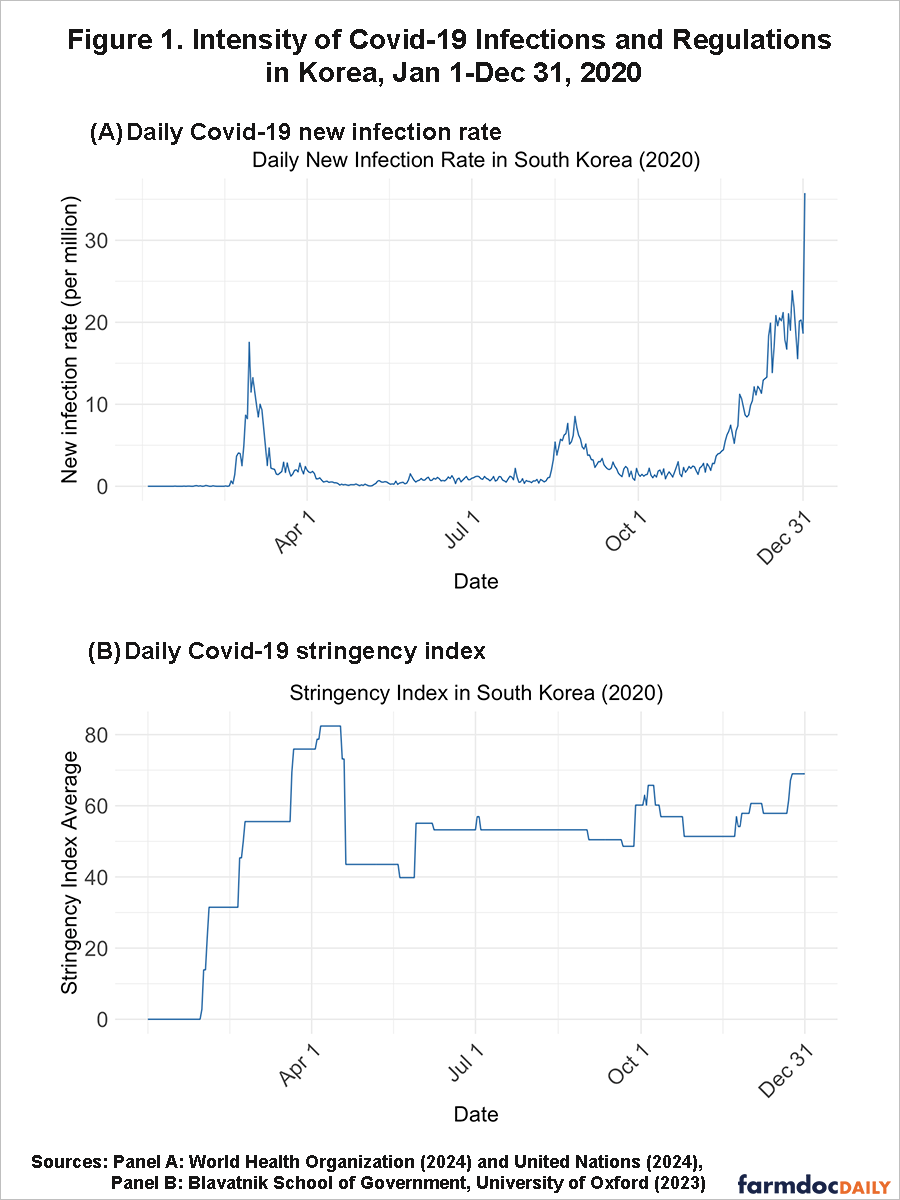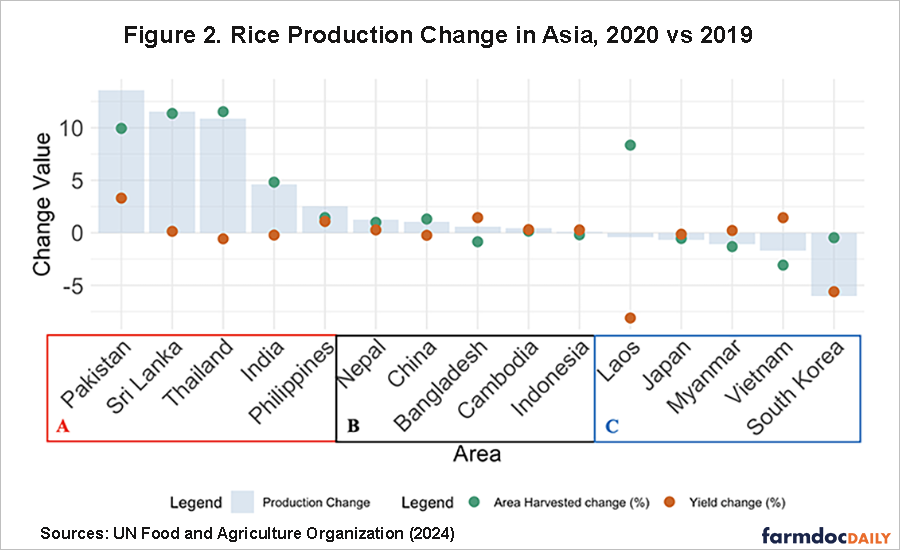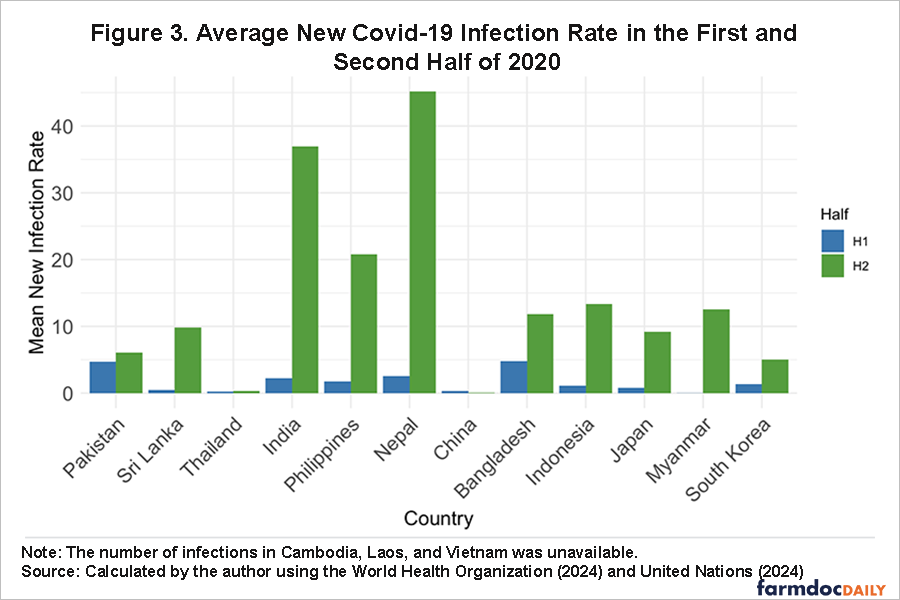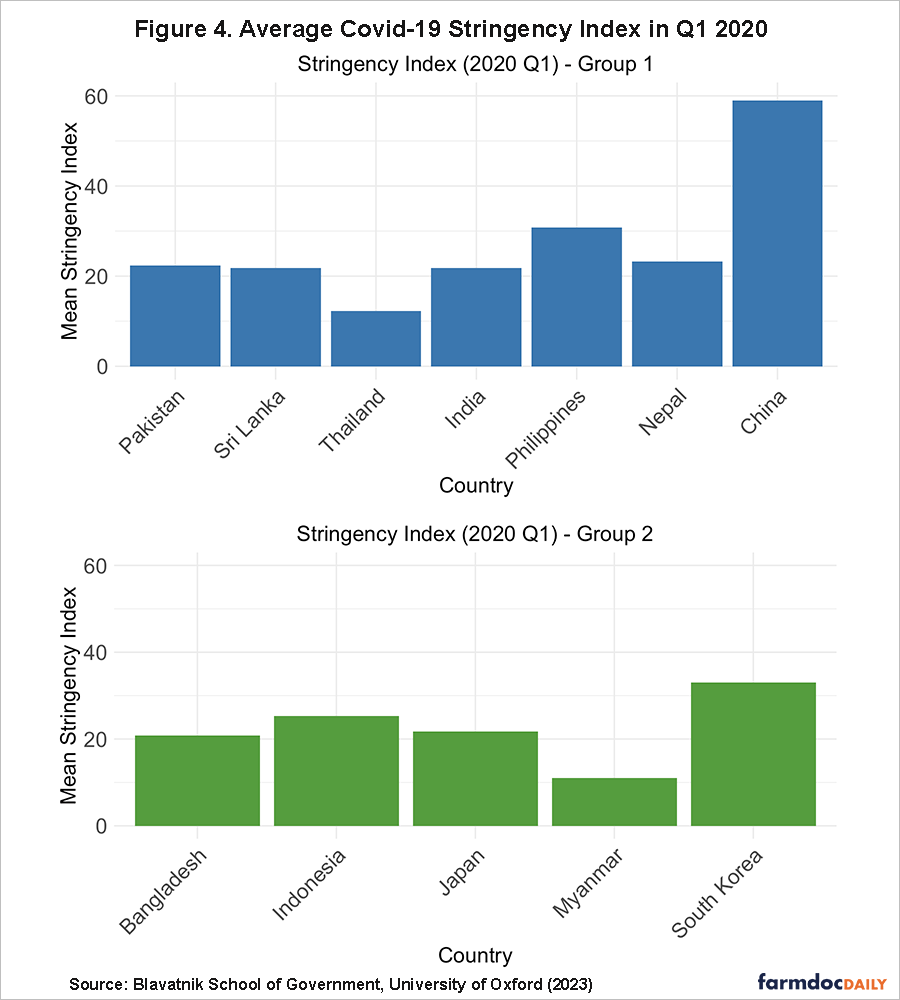Losses in Crop Production during the Covid-19 Pandemic in Korea
Note: This article was written by University of Illinois Agricultural and Consumer Economics Ph.D. student Jaehyun Kim and edited by Joe Janzen. It is one of several excellent articles written by graduate students in Prof. Janzen’s ACE 527 class in advanced agricultural price analysis this fall.
Covid-19 had negative effects on many industries. However, agricultural crop production suffered relatively limited damage during the pandemic. Worldwide, major agricultural crop commodities like corn, wheat, rice, oilseeds, and sugar actually showed production increases in 2020 compared to 2019 (Beckman and Countryman 2021).
Rice is a major component of the world’s food supply, especially in Asia. Overall, global rice production grew by 0.4% between 2019 and 2020, which was smaller than other crop growth. Rice production did increase in China and India, large Asian nations and the world’s two biggest rice producers. In contrast, South Korea experienced a decline in the production of various crops. Specifically, rice production in South Korea decreased by 6.0% compared to 2019.
We might expect rice and other grain production to be relatively resilient in the face of a global pandemic. Grain production is largely mechanized in many major producing areas and labor needs along the grain supply chain are relatively limited compared to many other agricultural goods. For example, Korea’s rice production mechanization rate was 98.6% according to the Korea Statistical Service (2024), making rice production in theory relatively less affected by pandemic-related labor disruptions. However, compared to countries where rice farming is more labor-dependent, South Korean rice production suffered greater losses during the pandemic.
This article analyzes the impact of the Covid-19 pandemic on agricultural crop supply, focusing on rice as a major staple crop in Asia. By examining South Korea’s response to the pandemic and its agricultural labor market characteristics compared to other countries, we seek to identify factors may exacerbate the impact of future disruptions on the agriculture sector. We suggest that demand and agricultural labor are key points of vulnerability, particularly when the agricultural workforce is aging as is the case in many developed countries.
Covid-19 Coincided with the 2020 Planting Season in Korea
As discussed above in the case of rice, Korea’s agricultural production declined in 2020. Lower production during 2020 contributed to a significant increase in agricultural product prices, resulting in a 3.6% increase in the total agricultural production value. Lower cultivated area notably impacted South Korea’s agricultural production in 2020. According to the Korea Rural Economic Institute (2021), the total agricultural land area in South Korea decreased by 1.2% compared to the previous year. Cultivated areas for staple crops, vegetables, and fruits decreased by 2.0%, 2.1%, and 2.4%, respectively. These reductions were slightly larger than the average annual rate of decline in cultivated areas for staple crops, vegetables, and fruits observed between 2000 and 2019. This raises the question: why did the reduction in cultivated area during the pandemic become more pronounced?
One obvious culprit is the pandemic itself: infections, lockdowns, and other regulations came at critical periods for rice farming in South Korea. Rice makes up about half of South Korea’s crop area; it follows a single-cropping system, where seedlings are grown in March and April, transplanted in May, and harvested between September and October. Figure 1 shows the rates of Covid-19 infection rates and the stringency of South Korea’s COVID-19 response policies during 2020. In Figure 1, panel (B), the Stringency Index ranges from 0 to 100, with higher values indicating stricter policies. Figure 1 indicates that new infection rates peaked in early March and policy stringency was elevated during the March-April preparation period for transplanting. As a result, farmers in South Korea faced greater challenges in being ready for planting compared to previous years. This may have to a reduction in cultivated area and thus production.
Rice Production Changes in Asia in 2020
To place the 2020 change in Korea’s rice production in context, we consider rice production changes throughout Asia using data from the Food and Agriculture Organization of the United Nations (FAO). From the 25 countries in South and East Asia, we select the top 15 based on rice production. Aggregate rice production in South and East Asia shows an increasing trend. In 2010, the production was 628 million tonnes; in 2019, right before the COVID-19 pandemic, it was 676 million tonnes. China and India had the largest shares of 2019 production at 31.0% and 26.4%, respectively. While rice production has increased with population growth generally in Asia, after the 2000s, China, Japan, and South Korea experienced strong economic growth but limited population growth. So in these countries rice production has declined over time and India has led recent increases in rice production.
Figure 2 focuses on rice production changes in the first year of the Covid-19 pandemic, comparing 2020 production to 2019. Among 15 countries, ten countries experienced rice production growth. Output declined in five countries. Group A experienced the largest increment in production, over 2.5%, and Group B experienced modest growth, similar to the global average growth. In Group C, most countries experienced a slight decline of less than 2%. South Korea was an outlier with its 6.0% decrease.
Figure 2 also illustrates the harvested area and yield changes, highlighting distinct patterns across groups. Group A countries generally showed increases in both metrics compared to the previous year. Group B countries experienced either slight increases in both value or a decline in one. In group C, Laos stands out with a significant increase in harvested area but a sharp decline in yield. This could be due to an expansion of rice cultivation in response to rising food demand and difficulties importing agricultural inputs during the pandemic, leading to reduced productivity. Finally, South Korea and Japan experienced decreases in both harvested area and yield.
Covid-19 in Asia in 2020
Figure 3 shows rates of new COVID-19 infections for larger Asian rice producing countries in the first and second halves of 2020. The first half corresponds to the period for determining cultivated areas and planting, while the second half relates to the cultivation and harvesting periods. Despite a decrease in harvested area, Japan and South Korea exhibited relatively low infection rates in both the first and second halves of the year compared to other countries.
Figure 4 illustrates the average Stringency Index for Covid-19 regulations in each country in the first quarter of 2020. In the first quarter, rice farmers decided on planting areas in Asia. The blue bars represent regions with an increase in harvested area, while the green bars represent regions with a decrease in harvested area. Except for China, all countries appear to have implemented policies of similar intensity.
Possible Covid-19 Crop Production Effects
While staple crop production changes and the burden of the Covid-19 pandemic displayed no obvious relation across countries, a deeper dive reveals suggestive evidence that increasing demand and differences in agricultural labor supply shaped varying responses across countries.
First, existing trends in domestic food demand appear to have influenced the expansion of cultivated areas. Countries expanding planted area are generally also experiencing food demand increases due to rapid population growth. India and its surrounding regions, which have some of the highest population growth rates globally, have steadily expanded their cultivated areas even before the pandemic. In contrast, South Korea and Japan have seen stagnant population growth following rapid economic development, leading to declining demand for rice. Consequently, both countries gradually reduced their rice cultivation areas even before the pandemic and this trend seems to have continued during the pandemic period.
Second, South Korea and Japan have agricultural labor supply limitations that may have made rice production there particularly susceptible to pandemic-related disruptions. Both countries face significant aging populations among farmers, contributing to labor shortages in the farming sector. According to the Korea Rural Economic Institute (2022), the average age of farm operators in South Korea in 2020 was 65.9, while the average age of agricultural workers in Japan was 68.4 in 2022. Addressing labor shortages caused by aging populations is a significant challenge for both countries. Given the relatively greater susceptibility of older people to Covid-19, constraints on agricultural labor may have been even more pronounced in 2020.
In South Korea, agriculture heavily depends on foreign labor. During the pandemic, the South Korean government restricted the entry of foreign workers. Although rice farming relies less on labor due to mechanization, it still employs a significant amount of hired labor. Restrictions on foreign workers may have led to a decline in labor supply and labor quality, potentially contributing to a decrease in rice production. Notably, younger countries who are less reliant on foreign labor generally did not see rice production declines during 2020 as large as Korea and Japan.
In summary, South Korea’s rice production declined during the pandemic, affected by changes in both cultivated area and yield. Two explanations are declines in domestic demand and labor shortages related to the pandemic. With relatively strict Covid-19 policies and high infection rates when cultivation area decisions were made, farmers’ decision-making was likely influenced. South Korea’s agriculture, heavily reliant on aging farmers, is inherently more vulnerable to such shocks. Currently, many developed countries are experiencing rapid aging of their farming populations. As more countries rely on foreign labor for agricultural work, unexpected disruptions in foreign labor supply could significantly impact domestic agricultural prices. The Covid-19 pandemic highlighted how all sectors of agriculture, even the relatively mechanized crop production sector, must consider how to address the complications of an aging farming population.
References
Beckman, J. and Countryman, A.M. (2021), The Importance of Agriculture in the Economy: Impacts from COVID-19. Amer. J. Agr. Econ., 103: 1595-1611. https://doi.org/10.1111/ajae.12212
Korea Rural Economic Institute. (2021). Agricultural Outlook 2021. Korea Rural Economic Institute. https://repository.krei.re.kr/handle/2018.oak/25263
Korea Rural Economic Institute. (2022). Korean agriculture in the world through statistics. Korea Rural Economic Institute. https://repository.krei.re.kr
Thomas Hale, Noam Angrist , Rafael Goldszmidt , Beatriz Kira, Anna Petherick , Toby Phillips, Samuel Webster, Emily Cameron-Blake , Laura Hallas, Saptarshi Majumdar, and Helen Tatlow. (2021). “A global panel database of pandemic policies (Oxford COVID-19 Government Response Tracker).” Nature Human Behaviour. https://doi.org/10.1038/s41562-021-01079-8.
Korea Statistical Service (2024). Rice Farm Mechanization rate. https://www.index.go.kr/unity/potal/main/EachDtlPageDetail.do?idx_cd=1288. Access date: Dec 1st, 2024.
Korea Statistical Service (2024). Age of farmers in Korea. https://www.index.go.kr/unity/potal/main/EachDtlPageDetail.do?idx_cd=2745 Access date: Dec 1st, 2024.
Food and Agriculture Organization (2024). https://www.fao.org/statistics/en/ Access date: Dec 1st, 2024.
Our World in Data. (2021). What is the COVID-19 Stringency Index? https://ourworldindata.org/metrics-explained-covid19-stringency-index.
United Nations (2024). World Population Prospects 2024. https://population.un.org/wpp/Download/Standard/MostUsed/. Access date: Dec 1st, 2024.
World Health Organization (2024). https://data.who.int/dashboards/covid19/cases. Access date: Dec 1st, 2024.
Disclaimer: We request all readers, electronic media and others follow our citation guidelines when re-posting articles from farmdoc daily. Guidelines are available here. The farmdoc daily website falls under University of Illinois copyright and intellectual property rights. For a detailed statement, please see the University of Illinois Copyright Information and Policies here.











